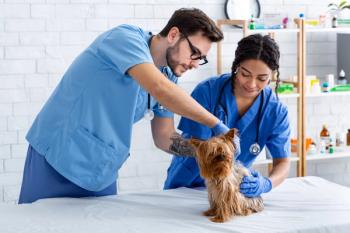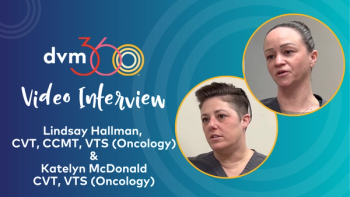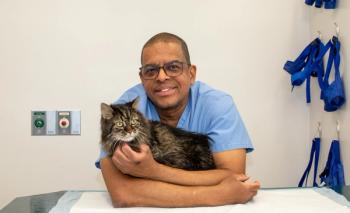
Portosystemic shunts in dogs (Proceedings)
Portosystemic shunts (PSS) are the result of reduced total hepatic blood flow and the inability of the liver to extract noxious substances from the portal circulation.
Portosystemic shunts (PSS) are the result of reduced total hepatic blood flow and the inability of the liver to extract noxious substances from the portal circulation. Many different patterns of portovascular anomaly have been described in dogs. The most common are single extrahepatic communications between the portal vein or one of the mesenteric veins and the caudal vena cava or the azygos vein in small-breed dogs and the patent ductus venosus in large-breed dogs. Hypoplasia or aplasia of intrahepatic portal vasculature could complicate any of these anomalies, but it is rare. In addition, intrahepatic arteriovenous fistulas which cause marked volume overload of the porta circulation system result in portal hypertension and acquired PSSs.
Congenital shunts
Congenital shunts occur more commonly in purebred dogs than in mixed breeds; miniature schnauzers, Yorkshire Terriers, and Irish Wolfhounds appear to be at increased risk. The prevalence of portosystemic shunts in certain breeds suggests an inherited predisposition. This has been proven only in Irish Wolfhounds, where a number of previously unknown genes appear to be involved.
Extrahepatic shunts are most common, accounting for 61% to 94% of congenital shunts, and are typically seen in small breeds of dogs, such as the Miniature Schnauzer and Yorkshire Terrier. Intrahepatic shunts represent between 6% and 40% of congenital shunts and are more common in large and giant breeds of dogs such as Irish Wolfhounds and Golden Retrievers. The majority of intrahepatic shunts are a result of the embryonic connection between the umbilical vein and the caudal vena cava remaining open; in most dogs this connection closes 3 days after birth but, for unknown reasons, remains open in dogs with intrahepatic congenital shunts.
Hepatic microvascular dysplasia is an unusual form of intrahepatic portosystemic shunting in which no gross vascular abnormality can be identified. This rare condition is associated with somewhat milder clinical signs and appears to be the consequence of a developmental abnormality; it has a higher prevalence in Cairn Terriers, suggesting a hereditary basis.
Acquired shunts
Acquired shunts arise secondary to diffuse liver disease where excessive and sustained pressure at some point within the portal vein causes embryonic, nonfunctional vascular communications to open. These are generally seen in older dogs with cirrhosis, hepatitis, or neoplasia of the liver. In contrast to congenital portosystemic shunts, a number of vessels are usually affected.
As veterinary technicians we have a significant role in triaging, diagnosing and especially nursing these patients back to a healthy state. Our training, knowledge and care can and, does often times, make all the difference in the outcome of these patients.
Pathogenesis and etiology
Portosystemic shunts abnormal vascular connections between the hepatic portal vein (the blood vessel that connects the gastrointestinal tract with the liver) and the systemic circulation. Such anomalies cause blood in the gastrointestinal track to be diverted past the liver, thereby limiting the liver's vital functions in metabolism and detoxification of compounds and the body's defenses against intestinally derived pathogens. This effectively exposes the body to toxic by-products of digestion (toxins and bacteria) and often times mimics the effects of liver failure. Portosystemic shunts can be present at birth (i.e. congenital) or acquired as the result of another disease process later in life. Congenital shunts are more common; representing approximately 75% of all canine cases, and generally result from anatomic abnormalities of the portal vasculature or persistence of fetal vessels. One or occasionally two vessels are involved, and the shunts are classified according to their location as either outside of (extrahepatic) or within (intrahepatic) the liver.
Signalment and history
Dogs with congenital portosystemic shunts are typically purebred dogs less than 1 year old. The severity of clinical signs varies and is related to the anatomic position of the shunt and the fraction of portal blood that is shunted past the liver. Generally, the lower the fraction of shunting, the milder and later in onset are the clinical signs. Nevertheless, affected animals are often in poor body condition and of small body stature, especially when compared to their littermates. Owners may complain that the animals fail to thrive or grow and that the skin and coat condition are poor. Other clinical signs tend to be intermittent or periodic in nature and relate to the central nervous system, gastrointestinal tract, and urinary tract. There may also be a history of an adverse response to sedation or anesthesia. A significant number of dogs (up to 25% of cases of portosystemic shunts) may develop signs later in life; this may be due to an acquired rather than congenital shunt or because the animal can no longer compensate for a low grade congenital shunt dogs with acquired shunts have signs similar to those with congenital disease, although the previous history may have been uneventful until the appearance of weight loss and associated clinical signs.
Clinical presentation
The central nervous system signs are the most common, occurring in over three-quarters of all cases, and may be vague and subtle such as anorexia, depression, and lethargy. More specific signs include episodes of hyperactivity, head pressing and circling, disorientation, temporary blindness, weakness, excess salivation, seizures, and occasionally coma. These signs tend to wax and wane, and their onset may be connected with the recent ingestion of a protein-rich meal that resulted in increased production of neurotoxins within the large intestine. Vomiting and/or diarrhea are present in about two-thirds of cases. Evidence of lower urinary tract disease is present in approximately one-half of cases and is usually due to ammonium urate crystals, which are formed because of excessive excretion of ammonia and uric acid in urine. Some dogs, particularly those that develop signs later in life, have polydipsia and polyuria (excessive drinking and urination). Other less common signs of portosystemic shunting include recurrent fevers and ascites, although the latter is generally seen only in dogs with acquired shunts.
Clinical signs
Diagnostic procedures
These generally include CBC (microcytosis/target cells), chemistry panel (low BUN, high ALP/TBILI), urinalysis (variable urine concentration, ammonium urate crystalluria, hematuria, pyuria or proteinuria), coagulation profiles (increased PT, APTT, PIVKA), abdominal ultrasonography (+liver aspirate), CT portovenography, and/or colorectal scintigraphy.
Treatment
The prognosis is generally good if recognized early in the course of the disease. Dogs are managed best with surgical ligation of the shunting vessel(s). If possible, it is preferred to have the patient as stable as possible prior to surgery. The goal of medical management is to improve the patient's health to a point where the risk of anesthesia and surgery is minimal. This may involves having the patient on a low protein diet and administering prescribed medication. Low protein diet should be fed in order to decrease poisons that affect the brain. Antibiotics are used as bacteria, which are normally removed by the liver, by pass the liver and result in bacteria circulating in the blood. Lactulose is prescribed to aide in trapping toxins such as ammonia in the stool; it also decreases the transit time of the stool so that toxins are expelled quicker (thus the pet will defecate more often). The ammonia level must be within a normal range and the animal must be neurologically normal in order to have the best chance for a surgical success.
For pets that have a shunt that is located outside (extrahepatic) of the liver, an ameroid constrictor ring is placed around the vessel. This device slowly closes the shunt over a period of 6 weeks. If the shunt is located in the liver (intrahepatic) the surgery is much more complex. Because these shunts are usually found in large breed dogs, the shunt likewise is frequently very large. Surgeons have successfully used large ameroid constrictors for this purpose, but in some cases two surgeries are needed. Most commonly, intrahepatic shunts still need to be hand-ligated because they are usually too large for the constrictor. At present most intrahepatic shunts are treated by placing coils in the vessel. This is performed by inserting a catheter into the vessel and releasing coils into the shunt. The shunt then closes off when the coil creates a clot in the vessel. The liver should always be biopsied at the time surgery takes place. If a shunt cannot be identified a portogram is performed. When the shunt is identified, full ligation (tying off the vessel) of the vessel is performed only if post-ligation portal pressure does not exceed 10 cm H20 (8 mmHg) above baseline pressures or 20-23 cm H2O (15-18 mmHg). Elevation in this pressure, called portal hypertension can result in death. Partial ligation is done if there is a risk of portal hypertension (pressure is too high). Acute portal hypertension results in abdominal distention, pain, bloody diarrhea, ileus and endotoxic shock (shock due to bacterial toxins). At present, ligation of the shunt is done using an ameroid constrictor. The ameroid constrictor is made of a hydroscopic casein material (material that loves water) in a stainless steel ring. It is placed around the shunt and fluid is absorbed. The casein material of the ring becomes progressively larger and gradually occludes the vessel over 4-5 weeks. The most rapid phase of occlusion occurs within the first 3-14 days and then the closure of the constrictor slows down for the remaining 3-4 weeks. This is considered a method of gradual occlusion. The vessel may also be occluded using cellophane. The tape will incite an inflammatory response and the vessel will slowly close down over a period of months.
Complications —Some animals with incomplete attenuation of the shunt may require lifelong medical management following the surgical repair. Complications after surgery include portal hypertension, which leads to splanchnic ischemia (loss of blood to abdominal organs) and death. Animals will show signs of ascites (fluid distention in the abdomen), vomiting, diarrhea, depression and respiratory distress. Up to 21% of the patients used to die of portal hypertension or fatal hemorrhage. This percentage has decreased by more than 11% since the use of the ameroid constrictor. Animals should also be monitored for seizure activity postoperatively. The cause of these seizures is unknown. It is possible that seizures occur because the brain has adapted to an altered metabolism or because of withdrawal of the anticonvulsant effects of endogenous benzodiazepines (valium-like substances that the body produced when the shunt was open) after ligation of the shunt. Seizures are managed with intravenous medication (Phenobarbital), oral medication (KBr - potassium bromide), or intravenous propofol (anesthetic agent).
Follow-up treatment
Monitoring clinical signs, appetite, body condition, weight, CBC, chemistry panels and urine. Nutritional support – essential to maintain body condition and optimal management of hepatic encephalopathy (degeneration of liver function, caused by any of various acquired disorders, including metabolic disease, organ failure, inflammation, and chronic infection). With better understanding of the pathophysiology of hepatic encephalopathy, it has become possible to prescribe specific therapies that provide a reasonable prognosis for those dogs with portosystemic shunts that are not corrected surgically. Medical management is indicated for all dogs with acquired shunts and all dogs with microvascular shunts. It should also be used for a period in those dogs that are about to undergo surgical ligation. Dietary manipulations for the control of hepatic encephalopathy are designed to limit neurotoxin production, which occurs principally in the large intestine, and to reduce the subsequent absorption of these toxins into the portal vein. The major toxins are all derived from nitrogenous materials (protein and urea) and are synthesized by bacteria found within the large intestine. The production of these toxins is reduced by limiting the amount of protein fed and ensuring that the dietary protein is high quality and very digestible. These steps reduce the amount of protein that reaches the large intestine; further reductions can be attained by feeding smaller meals more frequently to maximize the digestive capacity of the small intestine. Lactulose, is often used as a supplement for this purpose. Supplementation with zinc salts also improves the detoxification of ammonia and the control of hepatic encephalopathy. In addition, antibiotics are used in most cases to reduce the bacteria within the large intestine that are responsible for the production of neurotoxins. Orally administered neomycin is commonly used for this purpose and is often used in combination with lactulose in both the short and long-term medical management of portosystemic shunts.
Prognosis
The prognosis is excellent if the animal survives the immediate postoperative period. With partial ligation the prognosis is not as good. After 3 years, signs recur in 40-50% animals with partial shunt ligation. The overall success rate is about 85%. Usually the pet will start to feel better with 10 to 14 days after surgery.
Conclusion
Portosystemic shunts can only be prevented by not breeding affected animals and refraining from breeding the sires and dams of affected animals. Therefore, the best option once a patient presents with a portosystemic shunt is to pursue surgical ligation combined with medical management to provide the best outcome. There is quite a bit of nursing care that goes into assuring an optimal outcome which is where veterinary nursing care is crucial.
Newsletter
From exam room tips to practice management insights, get trusted veterinary news delivered straight to your inbox—subscribe to dvm360.





